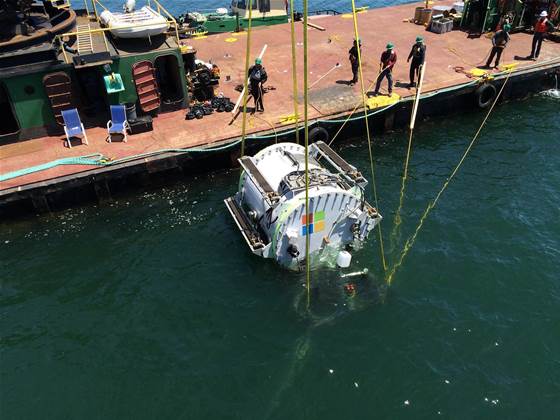Microsoft has deployed an experimental data centre on the seafloor off Scotland to trial if this is a viable approach to placing data processing and storage facilities nearer to customers.

The experimental Northern Isles pre-packaged data centre operates some 36 metres below the surface, and is part of Microsoft's long term Project Natick program that started in 2014.
Project Natick's goal is to determine if subsea data centres of different sizes that are left to operate 'lights out' with no maintenance on the sea floor for up to five years are viable.
Microsoft hopes that underwater, pre-packaged data centres will help it meet burgeoning demand for edge facilties.
Putting compute nearer to customers could result in lower data transmission latency and better service responsiveness.
More than half the world's population lives less than 200 kilometres from the coast, Microsoft noted.
Data centres in the water near coastal cities puts them closer to users, improving the performance of web apps and services, video streaming, games and the delivery of realistic artificial intelligence experiences, the company said.
The trial facility is officially called the Northen Isles SSDC-002 data centre.
It is 12.2 metres long and 3.18 metres wide, and contains 12 racks with 864 servers in total supplemented by field programmable gate array (FPGA) accelerator cards.
With a total of 27.6 petabytes of disk storage, the data centre has enough space for about five million full length movies.
The servers are powered by fully renewable electricity from wind farms and solar plants onshore, as well as tide and wave generation from the European Marine Energy Centre in the Orkney Islands, off Scotland.
They are cooled with circulating sea water, which is piped through radiators attached to the back of the racks, and the internal operating environment is filled with dry nitrogen at one atmosphere of pressure.
The data centre was towed out to sea where it was lowered underwater, switched on and connected to data backhaul to shore through a combined fibre-optic and power cable.
French marine engineering company Naval Group designed and built the subsea data centre for Microsoft.
Project Natick is currently in its second phase, with the initial part of the program having determined that underwater data centres are feasible through the deployment of a submerged facility off the coast of California in 2016.
The second part of Project Natick focuses on determining whether subsea data centres are logistically, environmentally and economically practical.


_(20).jpg&h=140&w=231&c=1&s=0)
_(22).jpg&h=140&w=231&c=1&s=0)





_(26).jpg&w=100&c=1&s=0)

 iTnews Executive Retreat - Security Leaders Edition
iTnews Executive Retreat - Security Leaders Edition











_(1).jpg&h=140&w=231&c=1&s=0)



